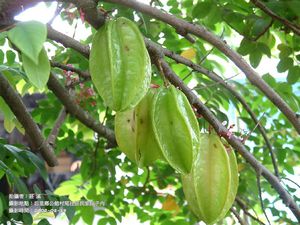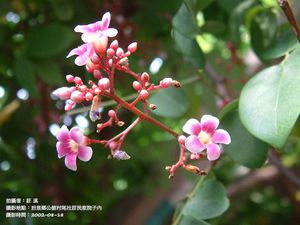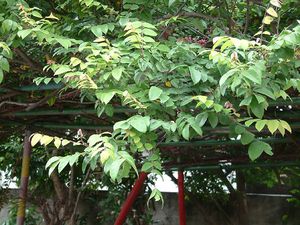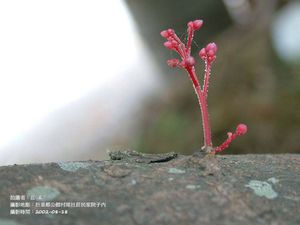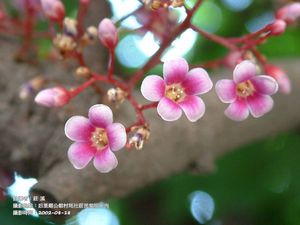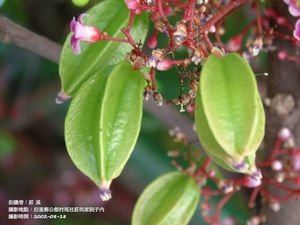楊桃
出自台灣有毒中草藥毒性資料庫
(以內容「__NOTOC__ [http://tcm-toxic.kmu.edu.tw/index.php/%E5%A4%A7%E6%88%9F%E7%A7%91 返回上一頁] {{:模板:基本資料|1=酢醬草科 Oxalidaceae|2=楊桃屬|3= 'Averrhoa...」創建新頁面) |
|||
| (10個中途的修訂版本沒有顯示) | |||
| 第1行: | 第1行: | ||
__NOTOC__ | __NOTOC__ | ||
| - | [http://tcm-toxic.kmu.edu.tw/index.php/%E5% | + | {| |
| + | ||[http://tcm-toxic.kmu.edu.tw/index.php/%E5%AD%B8%E5%90%8D 中英文學名] | ||
| + | |||
| + | ||[http://tcm-toxic.kmu.edu.tw/index.php/%E9%85%A2%E9%86%AC%E8%8D%89%E7%A7%91 科別] | ||
| + | |||
| + | ||[http://tcm-toxic.kmu.edu.tw/index.php/%E6%AF%92%E6%80%A7 毒性] | ||
| + | |||
| + | ||[http://tcm-toxic.kmu.edu.tw/index.php/%E7%97%87%E7%8B%80 症狀] | ||
| + | |} | ||
| + | <font size=4 color=red>本品僅罹患腎臟相關疾病患者較易引起中毒症狀,一般正常人請放心食用。</font> | ||
| + | |||
{{:模板:基本資料|1=酢醬草科 Oxalidaceae|2=楊桃屬|3= 'Averrhoa'|4=楊桃|5=''Averrhoa caramabola'' L.|6=Star fruit |7=洋桃、五斂子}} | {{:模板:基本資料|1=酢醬草科 Oxalidaceae|2=楊桃屬|3= 'Averrhoa'|4=楊桃|5=''Averrhoa caramabola'' L.|6=Star fruit |7=洋桃、五斂子}} | ||
== '''植物圖片''' == | == '''植物圖片''' == | ||
| + | <font size=4> | ||
{| border="2" style="border-collapse;" | {| border="2" style="border-collapse;" | ||
|| | || | ||
| - | [[檔案: | + | [[檔案:楊桃15.jpg|300px| ]] |
| - | + | 楊桃 | |
|| | || | ||
| - | [[檔案: | + | [[檔案:楊桃-花1.jpg|300px| ]] |
| - | + | 楊桃花 | |
|| | || | ||
| - | [[檔案: | + | [[檔案:楊桃06.jpg|300px| ]] |
| - | + | 楊桃葉 | |
|| | || | ||
|- | |- | ||
|| | || | ||
| - | [[檔案: | + | [[檔案:楊桃10.jpg|300px| ]] |
| - | + | 楊桃莖&芽 | |
|| | || | ||
| - | [[檔案: | + | [[檔案:楊桃18.jpg|300px| ]] |
| - | + | 楊桃花2 | |
|| | || | ||
| - | [[檔案: | + | [[檔案:楊桃19.jpg|300px| ]] |
| - | + | 楊桃2 | |
|} | |} | ||
| + | </font> | ||
== '''楊桃簡介''' == | == '''楊桃簡介''' == | ||
| - | <font size= | + | <font size=4> 楊桃為國人日常生活當中常食用的水果之一,其外觀特殊,呈現五角狀,有如星星一般,因此英文將它稱作star fruit。主要盛產於熱帶或亞熱帶地區,台灣、泰國、巴西等地均有種植。楊桃在種類上有分成酸味及甜味兩種,酸味的楊桃外型較小,含有較高量的草酸(oxalic acid);甜味的楊桃外形較大,草酸含量相較起來較低[1]。</font> |
| - | + | <font size=4 color=red>目前經由研究文獻發現,本身患有尿毒症或腎衰竭等腎臟疾病的病患,在服用楊桃或楊桃汁之後,有較大的機率出現癲癇、抽搐等神經相關的中毒情況,但目前並無發現腎臟功能正常的人服用楊桃後出現中毒症狀,因此罹患有腎臟相關疾病的患者,盡量避免食用楊桃相關製品。 | |
</font> | </font> | ||
| - | |||
== '''外觀簡述''' == | == '''外觀簡述''' == | ||
{| border="2" style="border-collapse;" | {| border="2" style="border-collapse;" | ||
|| | || | ||
| - | <font size= | + | <font size=4>'''莖'''</font> |
| - | ||<font size= | + | ||<font size=4>灌木或喬木,高可達 10 公尺,徑 10~20 公分;樹幹挺直,樹皮暗灰色,平滑,具多數枝條,枝條有時蔓長而能延伸很長;嫩枝、葉柄帶深紫色,幼嫩部分被短柔毛或光滑。</font> |
|- | |- | ||
|| | || | ||
| - | <font size= | + | <font size=4>'''葉'''</font> |
| - | ||<font size= | + | ||<font size=4>葉互生,奇數羽狀複葉,長 15~25 公分;小葉 5~11 枚,對生,具短柄,葉片卵狀橢圓形或到卵形,長 3~7 公分,寬 2~4 公分,先端銳尖,基部鈍或歪斜,紙質,全緣;表面呈暗綠色,背面顏色較淡;中肋及側脈於表面凹下而於背面隆起,側脈每邊 4~7 枚;表裡兩面皆光滑無毛或背面略有柔毛;葉柄長 2~5 公分,細長狀;小葉柄短,長 0.1~0.25 公分,光滑無毛;枝條之葉漸上部則愈大。</font> |
|- | |- | ||
|| | || | ||
| - | <font size= | + | <font size=4>'''花'''</font> |
| - | ||<font size= | + | ||<font size=4> 花小形,紅紫色,多數,開放時徑 0.4~0.5 公分,呈總狀短圓錐花序,由葉腋長出或側生於枝條及樹幹上;花序甚短,很少超過 3 公分;苞卵狀橢圓形,萼 5 枚,卵形或倒卵形三角形,先端鈍;花鐘狀,花瓣 5 枚,匙形或楔形,長 0.3~0.5 公分,上部帶淡藍紫色,基部白色,結合成筒狀;雄蕊 10 枚,但完全雄蕊僅有 5 枚,另 5 枚多無花藥;雌蕊 1 枚,柱頭 4~5 裂,子房具稜線 5 條。每年 4~9 月開花。</font> |
|- | |- | ||
|| | || | ||
| - | <font size= | + | <font size=4>'''果實'''</font> |
| - | ||<font size= | + | ||<font size=4> 果實為漿果,卵狀橢圓形,長 8~10 公分,徑 5~8 公分,果皮金黃或淡黃色半透明至琥珀色,表面平滑,具深 5 稜,如農家磟碡,橫斷面星狀;初時為綠色,後則為黃色或淡黃色;有種子 3~5 粒。5月至翌年3月間成熟;7~12 月為盛產期。</font> |
|} | |} | ||
| - | |||
== '''產地''' == | == '''產地''' == | ||
| - | <font size= | + | <font size=4>物種主產地起源多數認為是馬來西亞,台灣楊桃主要是在1800年由中國華南一帶引進[2]。 |
</font> | </font> | ||
| - | |||
=='''使用情況'''== | =='''使用情況'''== | ||
| - | <font size= | + | <font size=4>楊桃於台灣屬於經濟作物之一,全年均可生產,但多集中於春季時間,是國人主要食用水果之一。 </font> |
| - | + | ||
| 第81行: | 第89行: | ||
*1. 2,5-dimethoxy-3-undecylphenol | *1. 2,5-dimethoxy-3-undecylphenol | ||
*2. 5-methoxy-3-undecylphenol, | *2. 5-methoxy-3-undecylphenol, | ||
| - | *3. 5-O-methylembelin, | + | *3. 5-''O''-methylembelin, |
| - | *4. 2-dehydroxy-5-O-methylembelin | + | *4. 2-dehydroxy-5-''O''-methylembelin |
*5. 2-methoxy-3-nonylresorcinol | *5. 2-methoxy-3-nonylresorcinol | ||
| - | *6. 5-O-ethylembelin | + | *6. 5-''O''-ethylembelin |
| - | *7. 2-O-acetyl-5-O-methylembelin | + | *7. 2-''O''-acetyl-5-''O''-methylembelin |
*8. 3,7-dihydroxy-2,5-diundecylnaphthoquinone | *8. 3,7-dihydroxy-2,5-diundecylnaphthoquinone | ||
*9. 2,7-dihydroxy-8-methoxy-3,6-diundecyldibenzofuran-1,4-dione | *9. 2,7-dihydroxy-8-methoxy-3,6-diundecyldibenzofuran-1,4-dione | ||
*10. 2,8-dihydroxy-7-methoxy-3,9-diundecyldibenzofuran-1,4-dione | *10. 2,8-dihydroxy-7-methoxy-3,9-diundecyldibenzofuran-1,4-dione | ||
| - | *11. 10-hydroxy-4-O-methyl-2,11-diundecylgomphilactone | + | *11. 10-hydroxy-4-''O''-methyl-2,11-diundecylgomphilactone |
*12. 3-undecylresorcinol | *12. 3-undecylresorcinol | ||
</font> | </font> | ||
|- | |- | ||
|| | || | ||
| - | <font size= | + | <font size=4>'''葉'''[5]</font> |
| - | ||<font size= | + | ||<font size=4> |
| - | *1. apigenin-6-C-(2’’-O-α-L-rhamnopyranosyl)-β-L-fucopyranoside | + | *1. apigenin-6-C-(2’’-''O''-α-''L''-rhamnopyranosyl)-β-''L''-fucopyranoside |
</font> | </font> | ||
|- | |- | ||
|| | || | ||
| - | <font size= | + | <font size=4>'''花'''[6, 7] |
| - | ||<font size= | + | ||<font size=4> |
*1. 天門冬氨酸(aspartic acid)、蘇氨酸(threonine)、絲氨酸(serine)、谷氨酸(glutamine)、脯氨酸(proline)、甘氨酸(glycine)、丙氨酸(alanine)、颉氨酸(valine)、蛋氨酸(methionine)、色氨酸(tryptophan)、精氨酸(arginine)、組氨酸(histidine)、賴氨酸(lysine)、苯丙氨酸(phenylalanine)、酪氨酸(tyrosine)、亮氨酸(leucine)、異亮氨酸(isoleucine) | *1. 天門冬氨酸(aspartic acid)、蘇氨酸(threonine)、絲氨酸(serine)、谷氨酸(glutamine)、脯氨酸(proline)、甘氨酸(glycine)、丙氨酸(alanine)、颉氨酸(valine)、蛋氨酸(methionine)、色氨酸(tryptophan)、精氨酸(arginine)、組氨酸(histidine)、賴氨酸(lysine)、苯丙氨酸(phenylalanine)、酪氨酸(tyrosine)、亮氨酸(leucine)、異亮氨酸(isoleucine) | ||
*2. 銅、鋅、錳、鐵、鎂、鈣 | *2. 銅、鋅、錳、鐵、鎂、鈣 | ||
| 第107行: | 第115行: | ||
|- | |- | ||
|| | || | ||
| - | <font size= | + | <font size=4>'''果實'''[8-13]</font> |
| - | ||<font size= | + | ||<font size=4> |
*1. Carotenoids | *1. Carotenoids | ||
*2. (-)-Epicatechin | *2. (-)-Epicatechin | ||
| 第121行: | 第129行: | ||
=='''活性研究'''== | =='''活性研究'''== | ||
| - | <font size= | + | <font size=4> |
*1. 以80%乙醇(ethanol)萃取楊桃葉,再以已烷(hexane)、乙酸乙脂(ethyl acetate)及丁醇(butanol)分離後,給予以巴豆油(croton oil)誘導耳朵皮膚發炎的小鼠進行模擬治療。結果顯示三種萃取液(0.03-0.1 mg/ear)均有明顯的抑制巴豆油產生的發炎作用,並且有效降低骨髓過氧化酵素(myeloperoxidase, MPO)的活性[14]。 | *1. 以80%乙醇(ethanol)萃取楊桃葉,再以已烷(hexane)、乙酸乙脂(ethyl acetate)及丁醇(butanol)分離後,給予以巴豆油(croton oil)誘導耳朵皮膚發炎的小鼠進行模擬治療。結果顯示三種萃取液(0.03-0.1 mg/ear)均有明顯的抑制巴豆油產生的發炎作用,並且有效降低骨髓過氧化酵素(myeloperoxidase, MPO)的活性[14]。 | ||
*2. 楊桃目前也被報導有用於治療新生兒尿布疹所引起的皮膚糜爛[15]。 | *2. 楊桃目前也被報導有用於治療新生兒尿布疹所引起的皮膚糜爛[15]。 | ||
| 第133行: | 第141行: | ||
== '''毒性研究''' == | == '''毒性研究''' == | ||
| - | *<font size= | + | *<font size=4 color=green>'''症狀'''[21-23]</font> <font size=4> |
**1. 神經症狀(癲癇、意識障礙、四肢麻木、肌無力、抽搐) | **1. 神經症狀(癲癇、意識障礙、四肢麻木、肌無力、抽搐) | ||
**2. 腸胃道症狀(打嗝、嘔吐、失眠) | **2. 腸胃道症狀(打嗝、嘔吐、失眠) | ||
</font> | </font> | ||
| - | *<font size= | + | *<font size=4 color=green>'''有毒成分'''[24]</font> <font size=4> |
**1. 草酸(oxalic acid) | **1. 草酸(oxalic acid) | ||
**2. AcTx | **2. AcTx | ||
</font> | </font> | ||
| - | *<font size= | + | *<font size=4 color=green>'''中毒劑量'''</font> <font size=4> |
**未知 | **未知 | ||
</font> | </font> | ||
| - | *<font size= | + | *<font size=4 color=green>'''機轉'''</font> <font size=4> |
**未知 | **未知 | ||
</font> | </font> | ||
| - | *<font size= | + | *<font size=4 color=green>'''心臟毒性'''</font> <font size=4> |
| - | + | 2006年,Vasconcelos et al.等人以楊桃葉的水萃取物進行實驗,給予豚鼠(guinea pig)的離體心臟或右心房室,發現楊桃葉水萃物會引起不同程度的房室傳導阻礙(atrioventricular blocks),並且提高了QT interval、QRS波、右心房到希斯束(His bundle)的傳遞時間,抑制心搏速率、房室脈衝傳導及腦室壓力(intraventricular pressure) [25]。 | |
| - | + | ||
| - | + | ||
</font> | </font> | ||
| - | *<font size= | + | *<font size=4 color=green>'''神經毒性'''</font> <font size=4> |
| - | + | 經由案例報導發現患有尿毒症(uremia)、腎衰竭(renal failure)或其它等腎臟疾病的病患,若食用楊桃或飲用楊桃汁,有機會造成嚴重的併發症,最明顯的就是神經毒性。觀察文獻案例,常見的神經症狀為癲癇、抽搐、意識障礙、四肢無力麻木等。通常在食入楊桃6小時內就會出現此些症狀,更為嚴重的症狀如神智混亂、昏迷、重積性癲癇,甚至死亡[21-23]。 | |
| + | |||
| + | 針對此種毒性,Carolino et al. (2005)從楊桃中萃取出可能引起神經毒性的萃取物(AcTx),給予大鼠及小鼠後,發現AcTx並不會影響GABA及穀氨酸(glutamate)兩種神經傳遞物質的吸收或釋出量,但降低了GABA對於受器(receptor)的結合能力。在行為表現上,則發現實驗鼠出現了強直-陣攣性癲癇(tonic-clonic seizure)現象,之後轉變為重積性癲癇(status epilepticus) [24]。 | ||
| + | |||
| + | 除了AcTx之外,目前最被視為最有可能引起神經毒性的物質為草酸。經由老鼠實驗發現含有草酸的楊桃汁除了會引起癲癇或抽搐等神經症狀之外,部分實驗的老鼠最後都會導致死亡(>10.67 g/kg);相反的,在除去草酸的楊桃汁組別當中,老鼠均正常存活[26]。 | ||
| + | |||
| + | 另外一個值得注意的問題為Carolino et al. (2005)的研究中指出,AcTx (IC50=0.89 μM)會抑制神經傳遞物質GABA與其接受器結合;由腦波訊號(electroencephalography)也可看到在以AcTx (170 μM)對老鼠進行皮質顯微注射後30分鐘,老鼠出現了明顯持續癲癇狀態[24]。 | ||
| + | </font> | ||
| + | |||
| + | *<font size=4 color=green>'''胃腸道毒性'''</font> <font size=4> | ||
| + | 除了神經毒性外,最常見的另一類症狀即為腸胃道症狀,一般中毒者通常會先出現此類症狀,如打嗝、嘔吐、失眠等[21]。 | ||
| + | </font> | ||
| - | |||
| - | |||
=='''毒性分級'''== | =='''毒性分級'''== | ||
| - | <font size= | + | <font size=4>[http://tcm-toxic.kmu.edu.tw/index.php/%E6%AF%92%E6%80%A7%E5%88%86%E9%A1%9E 級數B, 等級2]</font> |
| + | |||
== '''參考文獻''' == | == '''參考文獻''' == | ||
| - | <font size= | + | <font size=4> |
| - | 1. | + | 1. Morton JF. Carambola. Miami, FL.: Julia F. Morton 1987, p.p.125-128. |
| - | 2. | + | 2. 行政院農業委員會農糧署. 楊桃. 2008. [http://www.afa.gov.tw/tenclassic_index.asp?CatID=90] |
| - | 3. | + | 3. Xu MJ, Deng ZW, Li M, Li J, Fu HZ, Proksch P, Lin WH. [http://www.ncbi.nlm.nih.gov/pubmed/15165134 Chemical constituents from the mangrove plant, Aegiceras corniculatum.] ''Journal of Natural Products'' 2004; 67: 762-766. |
| - | 4. | + | 4. Chakthong S, Chiraphan C, Jundee C, Chaowalit P, Voravuthikunchai SP. [http://www.sciencedirect.com/science/article/pii/S1001841710001282Alkyl phenols from the wood of Averrhoa carambola.] ''Chinese Chemical Letters'' 2010; 21: 1094-1096. |
| - | 5. | + | 5. Cazarolli LH, Folador P, Moresco HH, Brighente IMC, Pizzolatti MG, Silva FRMB. [http://www.ncbi.nlm.nih.gov/pubmed/19625113 Stimulatory effect of apigenin-6-C-beta-L-fucopyranoside on insulin secretion and glycogen synthesis.] ''European Journal of Medicinal Chemistry'' 2009; 44: 4668-4673. |
| - | 6. | + | 6. Zhu YL, Li SD, Zhong JP, Zhou XQ. Determination and Analysis of Amino Acids and Microelements in the Averrhoa Carambola L.Flower. GuangDong Chemical Industry 2011; 38: 125-126. |
| - | 7. | + | 7. Hall NT, Smoot JM, Knight RJ, Jr., Nagy S. [http://www.ncbi.nlm.nih.gov/pubmed/7451749 Protein and amino acid compositions of ten tropical fruits by gas-liquid chromatography.] ''Journal of Agricultural and Food Chemistry'' 1980; 28: 1217-1221. |
| - | 8. | + | 8. Adnan TAbT, Augustin MA, Ghazali HM. [http://psasir.upm.edu.my/2470/ Polyphenoloxidase from starfruit (Averrhoa carambola, L.).] ''Pertanika'' 1986; 9: 219-224. |
| - | 9. | + | 9. Wilson CW, Shaw PE, Knight RJ, Nagy S, Klim M. [http://pubs.acs.org/doi/abs/10.1021/jf00062a009 Volatile Constituents of Carambola (Averrhoa-Carambola L).] ''Journal of Agricultural and Food Chemistry'' 1985; 33: 199-201. |
| - | 10. | + | 10. Lutz A, Winterhalter P. [http://www.sciencedirect.com/science/article/pii/S0031942200898246 Dihydroabscisic Alcohol from Averrhoa-Carambola Fruit.] ''Phytochemistry'' 1994; 36: 811-812. |
| - | 11. | + | 11. Wilson CW, Shaw PE, Knight RJ. [http://pubs.acs.org/doi/abs/10.1021/jf00114a025 Analysis of oxalic acid in carambola (Averrhoa carambola L.) and spinach by high-performance liquid chromatography.] ''Journal of Agricultural and Food Chemistry'' 1982; 30: 1106-1108. |
| - | 12. | + | 12. Hosoi S, Shimizu E, Arimori K, Okumura M, Hidaka M, Yamada M, Sakushima A. [http://www.ncbi.nlm.nih.gov/pubmed/18404300 Analysis of CYP3A inhibitory components of star fruit (Averrhoa carambola L.) using liquid chromatography- mass spectrometry.] ''Journal of Natural Medicines'' 2008; 62: 345-348. |
| - | 13. | + | 13. Gross J, Ikan R, Eckhardt G. [http://www.sciencedirect.com/science/article/pii/S0031942200840406 Carotenoids of the Fruit of Averrhoa-Carambola.] ''Phytochemistry'' 1983; 22: 1479-1481. |
| - | 14. | + | 14. Cabrini DA, Moresco HH, Imazu P, da Silva CD, Pietrovski EF, Mendes DA, da Silveira Prudente A, Pizzolatti MG, Brighente IM, Otuki MF. [http://www.hindawi.com/journals/ecam/2011/908059/ Analysis of the Potential Topical Anti-Inflammatory Activity of Averrhoa carambola L. in Mice.] ''Evidence-based Complementary and Alternative Medicine'' 2011; 2011: 908059. |
| - | 15. | + | 15. 羅世杏. [http://www.ceps.com.tw/ec/ecjnlarticleView.aspx?jnlcattype=0&jnlptype=0&jnltype=0&jnliid=2552&issueiid=31533&atliid=440130 楊桃木葉治療嬰兒尿布疹43例臨床觀察.] ''右江民族醫學院學報'' 2006; 641. |
| - | 16. | + | 16. Luo XY, Huang JC, Yang X, Wang LH, Huang RB. Antioxidative effect of Yangtaogen ( carambola root) polysaccharide ( YTGP) in vitro. Chinese Journal of Hospital Pharmacy 2011; 31: 1172-1174. |
| + | |||
| + | 17. Azeem AK, Mathew M, Nair C, Dilip.C. [http://www.sciencedirect.com/science/article/pii/S1995764510601484 Hepatoprotective effect of Averrhoea carambola fruit extract on carbon tetrachloride induced hepatotoxicity in mice.] ''Asian Pacific Journal of Tropical Medicine'' 2010; 610-613. | ||
| + | |||
| + | 18. Soncini R, Santiago MB, Orlandi L, Moraes GO, Peloso AL, dos Santos MH, Alves-da-Silva G, Paffaro VA, Jr., Bento AC, Giusti-Paiva A. [http://www.ncbi.nlm.nih.gov/pubmed/20937374 Hypotensive effect of aqueous extract of Averrhoa carambola L. (Oxalidaceae) in rats: an in vivo and in vitro approach.] ''Journal of Ethnopharmacology'' 2011; 133: 353-357. | ||
| + | |||
| + | 19. Zhang JW, Liu Y, Cheng J, Li W, Ma H, Liu HT, Sun J, Wang LM, He YQ, Wang Y, Wang ZT, Yang L. [http://ejournals.library.ualberta.ca/index.php/JPPS/article/view/776 Inhibition of human liver cytochrome P450 by star fruit juice.] ''Journal of Pharmacy & Pharmaceutical Sciences'' 2007; 10: 496-503. | ||
| + | |||
| + | 20. Cazarolli LH, Folador P, Moresco HH, Brighente IM, Pizzolatti MG, Silva FR. [http://www.ncbi.nlm.nih.gov/pubmed/19070612 Mechanism of action of the stimulatory effect of apigenin-6-C-(2''-O-alpha-l-rhamnopyranosyl)-beta-L-fucopyranoside on 14C-glucose uptake.] ''Chemico-biological interactions'' 2009; 179: 407-412. | ||
| + | |||
| + | 21. Neto MM, da Costa JAC, Garcia-Cairasco N, Netto JC, Nakagawa B, Dantas M. [http://ndt.oxfordjournals.org/content/18/1/120.full Intoxication by star fruit (Averrhoa carambola) in 32 uraemic patients: treatment and outcome.] ''Nephrology Dialysis Transplantation'' 2003; 18: 120-125. | ||
| + | |||
| + | 22. Chang JM, Hwang SJ, Kuo HT, Tsai JC, Guh JY, Chen HC, Tsai JH, Lai YH. [http://www.ncbi.nlm.nih.gov/pubmed/10676715 Fatal outcome after ingestion of star fruit (Averrhoa carambola) in uremic patients.] ''American Journal of Kidney Diseases'' 2000; 35: 189-193. | ||
| + | |||
| + | 23. Neto MM, Robl F, Netto JC. [http://www.ncbi.nlm.nih.gov/pubmed/9550629 Intoxication by star fruit (Averrhoa carambola) in six dialysis patients? (Preliminary report).] ''Nephrology Dialysis Transplantation'' 1998; 13: 570-572. | ||
| + | |||
| + | 24. Carolino RO, Beleboni RO, Pizzo AB, Vecchio FD, Garcia-Cairasco N, Moyses-Neto M, Santos WF, Coutinho-Netto J. [http://www.ncbi.nlm.nih.gov/pubmed/15843046 Convulsant activity and neurochemical alterations induced by a fraction obtained from fruit Averrhoa carambola (Oxalidaceae: Geraniales).] ''Neurochemistry International'' 2005; 46: 523-531. | ||
| + | |||
| + | 25. Vasconcelos CML, Araujo MS, Conde-Garcia EA. [http://www.ncbi.nlm.nih.gov/pubmed/16785041 Electrophysiological effects of the aqueous extract of Averrhoa carambola L. leaves on the guinea pig heart.] ''Phytomedicine'' 2006; 13: 501-508. | ||
| + | |||
| + | 26. Chen CL, Chou KJ, Wang JS, Yeh JH, Fang HC, Chung HM. [http://www.ncbi.nlm.nih.gov/pubmed/12101851 Neurotoxic effects of carambola in rats: the role of oxalate.] ''Journal of the Formosan Medical Association'' 2002; 101: 337-341. | ||
</font> | </font> | ||
| - | [http://tcm-toxic.kmu.edu.tw/index.php/%E5% | + | {| |
| + | ||[http://tcm-toxic.kmu.edu.tw/index.php/%E5%AD%B8%E5%90%8D 中英文學名] | ||
| + | |||
| + | ||[http://tcm-toxic.kmu.edu.tw/index.php/%E9%85%A2%E9%86%AC%E8%8D%89%E7%A7%91 科別] | ||
| + | |||
| + | ||[http://tcm-toxic.kmu.edu.tw/index.php/%E6%AF%92%E6%80%A7 毒性] | ||
| + | |||
| + | ||[http://tcm-toxic.kmu.edu.tw/index.php/%E7%97%87%E7%8B%80 症狀] | ||
| + | |} | ||
在2012年8月13日 (一) 03:46的最新修訂版本
| 中英文學名 | 科別 | 毒性 | 症狀 |
本品僅罹患腎臟相關疾病患者較易引起中毒症狀,一般正常人請放心食用。
基本資料
|
科別 | 酢醬草科 Oxalidaceae |
|
屬名 | 楊桃屬 Averrhoa |
|
中文學名 | 楊桃 |
|
拉丁學名 | Averrhoa caramabola L. |
|
英文名稱 | Star fruit |
|
中文俗名 | 洋桃、五斂子 |
植物圖片
|
楊桃 |
楊桃花 |
楊桃葉 | |
|
楊桃莖&芽 |
楊桃花2 |
楊桃2 |
楊桃簡介
楊桃為國人日常生活當中常食用的水果之一,其外觀特殊,呈現五角狀,有如星星一般,因此英文將它稱作star fruit。主要盛產於熱帶或亞熱帶地區,台灣、泰國、巴西等地均有種植。楊桃在種類上有分成酸味及甜味兩種,酸味的楊桃外型較小,含有較高量的草酸(oxalic acid);甜味的楊桃外形較大,草酸含量相較起來較低[1]。
目前經由研究文獻發現,本身患有尿毒症或腎衰竭等腎臟疾病的病患,在服用楊桃或楊桃汁之後,有較大的機率出現癲癇、抽搐等神經相關的中毒情況,但目前並無發現腎臟功能正常的人服用楊桃後出現中毒症狀,因此罹患有腎臟相關疾病的患者,盡量避免食用楊桃相關製品。
外觀簡述
|
莖 | 灌木或喬木,高可達 10 公尺,徑 10~20 公分;樹幹挺直,樹皮暗灰色,平滑,具多數枝條,枝條有時蔓長而能延伸很長;嫩枝、葉柄帶深紫色,幼嫩部分被短柔毛或光滑。 |
|
葉 | 葉互生,奇數羽狀複葉,長 15~25 公分;小葉 5~11 枚,對生,具短柄,葉片卵狀橢圓形或到卵形,長 3~7 公分,寬 2~4 公分,先端銳尖,基部鈍或歪斜,紙質,全緣;表面呈暗綠色,背面顏色較淡;中肋及側脈於表面凹下而於背面隆起,側脈每邊 4~7 枚;表裡兩面皆光滑無毛或背面略有柔毛;葉柄長 2~5 公分,細長狀;小葉柄短,長 0.1~0.25 公分,光滑無毛;枝條之葉漸上部則愈大。 |
|
花 | 花小形,紅紫色,多數,開放時徑 0.4~0.5 公分,呈總狀短圓錐花序,由葉腋長出或側生於枝條及樹幹上;花序甚短,很少超過 3 公分;苞卵狀橢圓形,萼 5 枚,卵形或倒卵形三角形,先端鈍;花鐘狀,花瓣 5 枚,匙形或楔形,長 0.3~0.5 公分,上部帶淡藍紫色,基部白色,結合成筒狀;雄蕊 10 枚,但完全雄蕊僅有 5 枚,另 5 枚多無花藥;雌蕊 1 枚,柱頭 4~5 裂,子房具稜線 5 條。每年 4~9 月開花。 |
|
果實 | 果實為漿果,卵狀橢圓形,長 8~10 公分,徑 5~8 公分,果皮金黃或淡黃色半透明至琥珀色,表面平滑,具深 5 稜,如農家磟碡,橫斷面星狀;初時為綠色,後則為黃色或淡黃色;有種子 3~5 粒。5月至翌年3月間成熟;7~12 月為盛產期。 |
產地
物種主產地起源多數認為是馬來西亞,台灣楊桃主要是在1800年由中國華南一帶引進[2]。
使用情況
楊桃於台灣屬於經濟作物之一,全年均可生產,但多集中於春季時間,是國人主要食用水果之一。
活性成份
|
莖[3, 4] |
|
|
葉[5] |
|
|
花[6, 7] |
|
|
果實[8-13] |
|
活性研究
- 1. 以80%乙醇(ethanol)萃取楊桃葉,再以已烷(hexane)、乙酸乙脂(ethyl acetate)及丁醇(butanol)分離後,給予以巴豆油(croton oil)誘導耳朵皮膚發炎的小鼠進行模擬治療。結果顯示三種萃取液(0.03-0.1 mg/ear)均有明顯的抑制巴豆油產生的發炎作用,並且有效降低骨髓過氧化酵素(myeloperoxidase, MPO)的活性[14]。
- 2. 楊桃目前也被報導有用於治療新生兒尿布疹所引起的皮膚糜爛[15]。
- 3. 楊桃根多醣抑制過氧化離子及氫氧根離子,且降低小鼠肝中的抗脂質氧化物質丙二醛(MDA)含量[16]。
- 4. 以楊桃果實萃取物餵食小鼠0.9 g/kg/day,連續七天,可降低因四氯化碳而升高的AST、ALT及ALP含量,並且提高glutathione含量[17]。
- 5. 在巴西的民俗醫療當中,楊桃葉被用於治療高血壓。Soncini et al. (2011)以楊桃葉水萃物(12.5-50 mg/kg)靜脈給予血壓正常大鼠,血壓呈現劑量相關的下降。同時以體外方式,對大鼠胸大動脈給予楊桃葉水萃物可有效抑制其收縮能力,主要機轉為藉由阻斷鈣離子通道,使細胞外鈣離子流無法進入胞內[18]。
- 6. 以楊桃汁抑制cytochrome P450 enzymes,包含CYP2A6>1A2>2D6>2E1>2C8>2C9>3A4 (按照抑制程度,由高至低排列)[19]。
- 7. 楊桃葉中的 apigenin-6-C-(2’’-O-α-L-rhamnopyranosyl)-β-L-fucopyranoside經萃取純化後給予患有糖尿病的老鼠,可觀察到兩個現象,第一為可促進insulin分泌,降低高血糖現象;第二為直接促進葡萄糖吸收,增強糖原(glycogen)合成,達到降低血糖作用[5, 20]。
毒性研究
- 症狀[21-23]
- 1. 神經症狀(癲癇、意識障礙、四肢麻木、肌無力、抽搐)
- 2. 腸胃道症狀(打嗝、嘔吐、失眠)
- 有毒成分[24]
- 1. 草酸(oxalic acid)
- 2. AcTx
- 中毒劑量
- 未知
- 機轉
- 未知
- 心臟毒性
2006年,Vasconcelos et al.等人以楊桃葉的水萃取物進行實驗,給予豚鼠(guinea pig)的離體心臟或右心房室,發現楊桃葉水萃物會引起不同程度的房室傳導阻礙(atrioventricular blocks),並且提高了QT interval、QRS波、右心房到希斯束(His bundle)的傳遞時間,抑制心搏速率、房室脈衝傳導及腦室壓力(intraventricular pressure) [25]。
- 神經毒性
經由案例報導發現患有尿毒症(uremia)、腎衰竭(renal failure)或其它等腎臟疾病的病患,若食用楊桃或飲用楊桃汁,有機會造成嚴重的併發症,最明顯的就是神經毒性。觀察文獻案例,常見的神經症狀為癲癇、抽搐、意識障礙、四肢無力麻木等。通常在食入楊桃6小時內就會出現此些症狀,更為嚴重的症狀如神智混亂、昏迷、重積性癲癇,甚至死亡[21-23]。
針對此種毒性,Carolino et al. (2005)從楊桃中萃取出可能引起神經毒性的萃取物(AcTx),給予大鼠及小鼠後,發現AcTx並不會影響GABA及穀氨酸(glutamate)兩種神經傳遞物質的吸收或釋出量,但降低了GABA對於受器(receptor)的結合能力。在行為表現上,則發現實驗鼠出現了強直-陣攣性癲癇(tonic-clonic seizure)現象,之後轉變為重積性癲癇(status epilepticus) [24]。
除了AcTx之外,目前最被視為最有可能引起神經毒性的物質為草酸。經由老鼠實驗發現含有草酸的楊桃汁除了會引起癲癇或抽搐等神經症狀之外,部分實驗的老鼠最後都會導致死亡(>10.67 g/kg);相反的,在除去草酸的楊桃汁組別當中,老鼠均正常存活[26]。
另外一個值得注意的問題為Carolino et al. (2005)的研究中指出,AcTx (IC50=0.89 μM)會抑制神經傳遞物質GABA與其接受器結合;由腦波訊號(electroencephalography)也可看到在以AcTx (170 μM)對老鼠進行皮質顯微注射後30分鐘,老鼠出現了明顯持續癲癇狀態[24]。
- 胃腸道毒性
除了神經毒性外,最常見的另一類症狀即為腸胃道症狀,一般中毒者通常會先出現此類症狀,如打嗝、嘔吐、失眠等[21]。
毒性分級
參考文獻
1. Morton JF. Carambola. Miami, FL.: Julia F. Morton 1987, p.p.125-128.
2. 行政院農業委員會農糧署. 楊桃. 2008. [1]
3. Xu MJ, Deng ZW, Li M, Li J, Fu HZ, Proksch P, Lin WH. Chemical constituents from the mangrove plant, Aegiceras corniculatum. Journal of Natural Products 2004; 67: 762-766.
4. Chakthong S, Chiraphan C, Jundee C, Chaowalit P, Voravuthikunchai SP. phenols from the wood of Averrhoa carambola. Chinese Chemical Letters 2010; 21: 1094-1096.
5. Cazarolli LH, Folador P, Moresco HH, Brighente IMC, Pizzolatti MG, Silva FRMB. Stimulatory effect of apigenin-6-C-beta-L-fucopyranoside on insulin secretion and glycogen synthesis. European Journal of Medicinal Chemistry 2009; 44: 4668-4673.
6. Zhu YL, Li SD, Zhong JP, Zhou XQ. Determination and Analysis of Amino Acids and Microelements in the Averrhoa Carambola L.Flower. GuangDong Chemical Industry 2011; 38: 125-126.
7. Hall NT, Smoot JM, Knight RJ, Jr., Nagy S. Protein and amino acid compositions of ten tropical fruits by gas-liquid chromatography. Journal of Agricultural and Food Chemistry 1980; 28: 1217-1221.
8. Adnan TAbT, Augustin MA, Ghazali HM. Polyphenoloxidase from starfruit (Averrhoa carambola, L.). Pertanika 1986; 9: 219-224.
9. Wilson CW, Shaw PE, Knight RJ, Nagy S, Klim M. Volatile Constituents of Carambola (Averrhoa-Carambola L). Journal of Agricultural and Food Chemistry 1985; 33: 199-201.
10. Lutz A, Winterhalter P. Dihydroabscisic Alcohol from Averrhoa-Carambola Fruit. Phytochemistry 1994; 36: 811-812.
11. Wilson CW, Shaw PE, Knight RJ. Analysis of oxalic acid in carambola (Averrhoa carambola L.) and spinach by high-performance liquid chromatography. Journal of Agricultural and Food Chemistry 1982; 30: 1106-1108.
12. Hosoi S, Shimizu E, Arimori K, Okumura M, Hidaka M, Yamada M, Sakushima A. Analysis of CYP3A inhibitory components of star fruit (Averrhoa carambola L.) using liquid chromatography- mass spectrometry. Journal of Natural Medicines 2008; 62: 345-348.
13. Gross J, Ikan R, Eckhardt G. Carotenoids of the Fruit of Averrhoa-Carambola. Phytochemistry 1983; 22: 1479-1481.
14. Cabrini DA, Moresco HH, Imazu P, da Silva CD, Pietrovski EF, Mendes DA, da Silveira Prudente A, Pizzolatti MG, Brighente IM, Otuki MF. Analysis of the Potential Topical Anti-Inflammatory Activity of Averrhoa carambola L. in Mice. Evidence-based Complementary and Alternative Medicine 2011; 2011: 908059.
15. 羅世杏. 楊桃木葉治療嬰兒尿布疹43例臨床觀察. 右江民族醫學院學報 2006; 641.
16. Luo XY, Huang JC, Yang X, Wang LH, Huang RB. Antioxidative effect of Yangtaogen ( carambola root) polysaccharide ( YTGP) in vitro. Chinese Journal of Hospital Pharmacy 2011; 31: 1172-1174.
17. Azeem AK, Mathew M, Nair C, Dilip.C. Hepatoprotective effect of Averrhoea carambola fruit extract on carbon tetrachloride induced hepatotoxicity in mice. Asian Pacific Journal of Tropical Medicine 2010; 610-613.
18. Soncini R, Santiago MB, Orlandi L, Moraes GO, Peloso AL, dos Santos MH, Alves-da-Silva G, Paffaro VA, Jr., Bento AC, Giusti-Paiva A. Hypotensive effect of aqueous extract of Averrhoa carambola L. (Oxalidaceae) in rats: an in vivo and in vitro approach. Journal of Ethnopharmacology 2011; 133: 353-357.
19. Zhang JW, Liu Y, Cheng J, Li W, Ma H, Liu HT, Sun J, Wang LM, He YQ, Wang Y, Wang ZT, Yang L. Inhibition of human liver cytochrome P450 by star fruit juice. Journal of Pharmacy & Pharmaceutical Sciences 2007; 10: 496-503.
20. Cazarolli LH, Folador P, Moresco HH, Brighente IM, Pizzolatti MG, Silva FR. Mechanism of action of the stimulatory effect of apigenin-6-C-(2-O-alpha-l-rhamnopyranosyl)-beta-L-fucopyranoside on 14C-glucose uptake. Chemico-biological interactions 2009; 179: 407-412.
21. Neto MM, da Costa JAC, Garcia-Cairasco N, Netto JC, Nakagawa B, Dantas M. Intoxication by star fruit (Averrhoa carambola) in 32 uraemic patients: treatment and outcome. Nephrology Dialysis Transplantation 2003; 18: 120-125.
22. Chang JM, Hwang SJ, Kuo HT, Tsai JC, Guh JY, Chen HC, Tsai JH, Lai YH. Fatal outcome after ingestion of star fruit (Averrhoa carambola) in uremic patients. American Journal of Kidney Diseases 2000; 35: 189-193.
23. Neto MM, Robl F, Netto JC. Intoxication by star fruit (Averrhoa carambola) in six dialysis patients? (Preliminary report). Nephrology Dialysis Transplantation 1998; 13: 570-572.
24. Carolino RO, Beleboni RO, Pizzo AB, Vecchio FD, Garcia-Cairasco N, Moyses-Neto M, Santos WF, Coutinho-Netto J. Convulsant activity and neurochemical alterations induced by a fraction obtained from fruit Averrhoa carambola (Oxalidaceae: Geraniales). Neurochemistry International 2005; 46: 523-531.
25. Vasconcelos CML, Araujo MS, Conde-Garcia EA. Electrophysiological effects of the aqueous extract of Averrhoa carambola L. leaves on the guinea pig heart. Phytomedicine 2006; 13: 501-508.
26. Chen CL, Chou KJ, Wang JS, Yeh JH, Fang HC, Chung HM. Neurotoxic effects of carambola in rats: the role of oxalate. Journal of the Formosan Medical Association 2002; 101: 337-341.
| 中英文學名 | 科別 | 毒性 | 症狀 |
